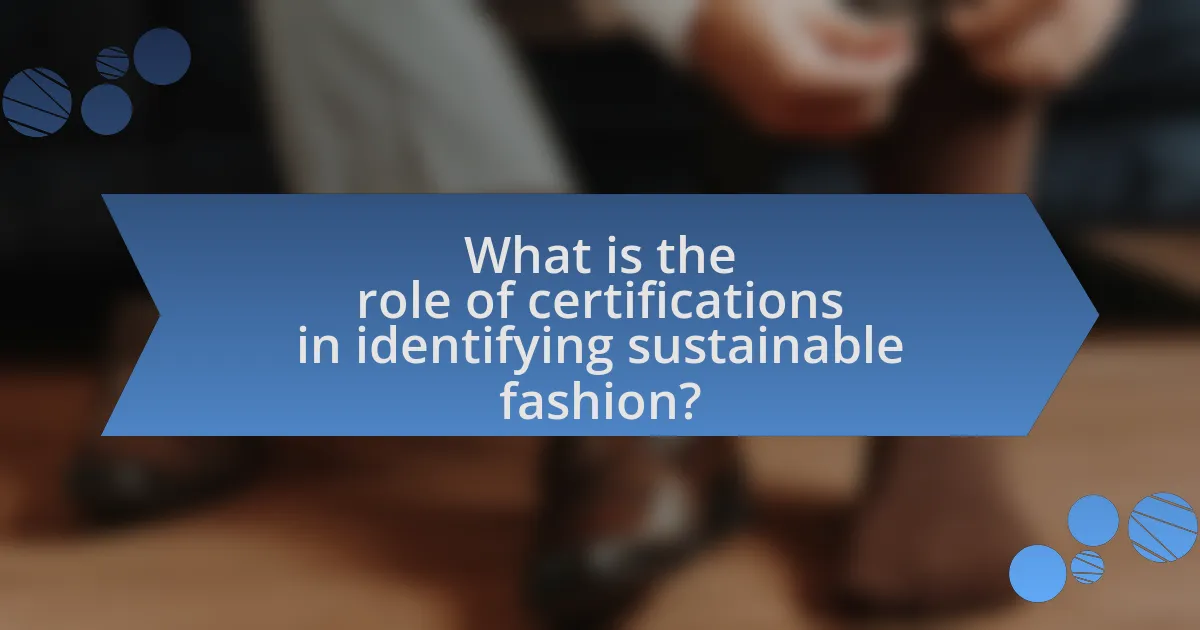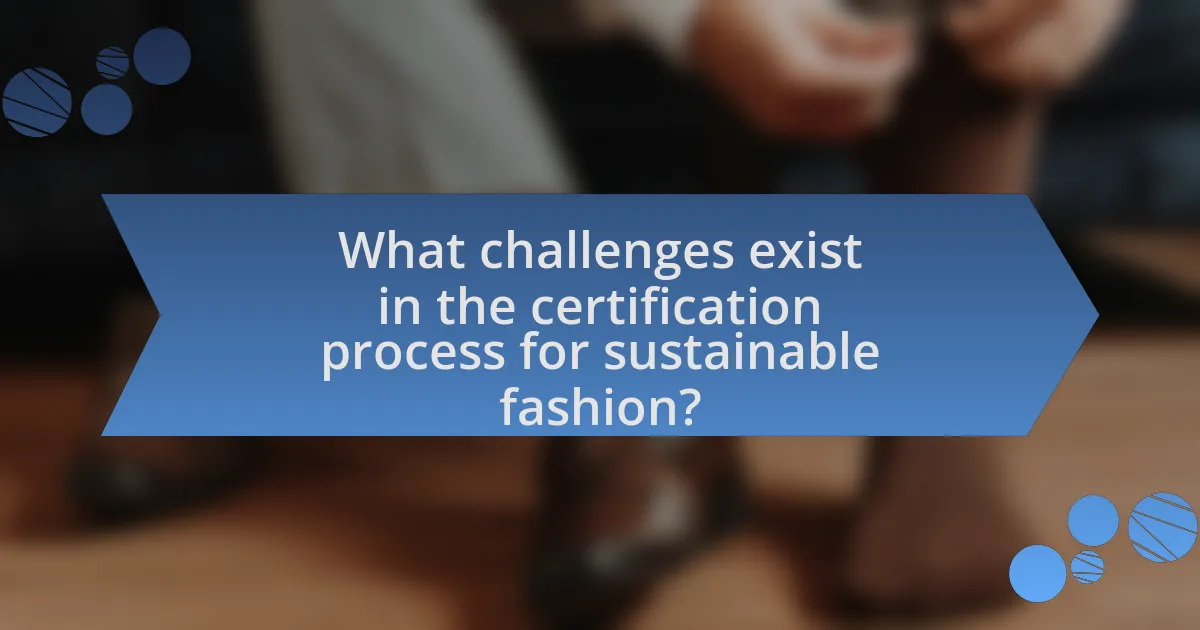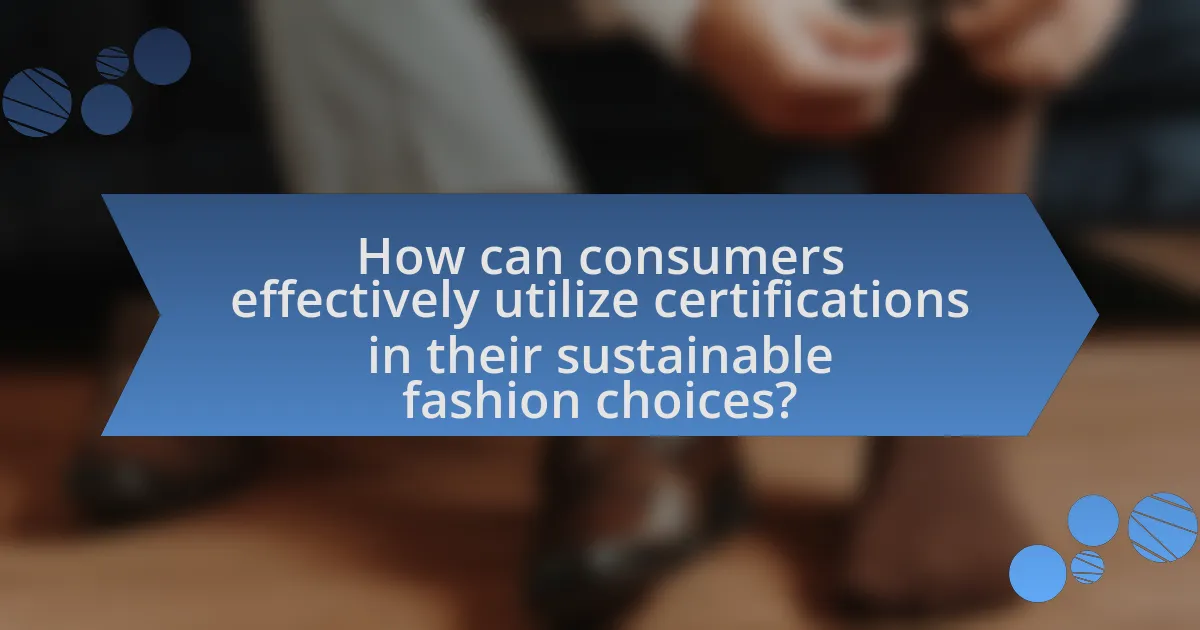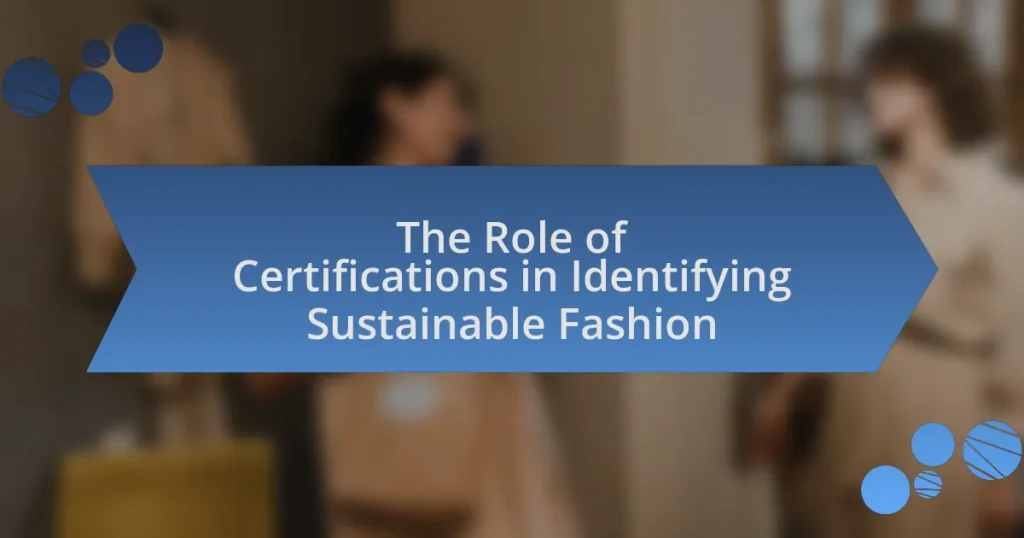The article focuses on the role of certifications in identifying sustainable fashion, highlighting their importance in ensuring environmental and social responsibility within the industry. It discusses various certifications, such as Global Organic Textile Standard (GOTS) and Fair Trade, which set verified standards for brands to follow, promoting ethical practices and consumer trust. The article also addresses the challenges brands face in obtaining certifications, including high costs and varying standards, while emphasizing the significance of consumer awareness in navigating these discrepancies. Additionally, it outlines strategies for consumers to effectively utilize certifications in their sustainable fashion choices, ensuring informed purchasing decisions that support sustainable practices.

What is the role of certifications in identifying sustainable fashion?
Certifications play a crucial role in identifying sustainable fashion by providing verified standards that brands must meet to demonstrate their commitment to environmental and social responsibility. These certifications, such as Global Organic Textile Standard (GOTS) and Fair Trade, ensure that products are made using sustainable practices, including organic materials and fair labor conditions. For instance, GOTS certification requires that at least 70% of the textile fibers be organic, and it also mandates strict environmental and social criteria throughout the supply chain. This verification process helps consumers make informed choices, as they can trust that certified products adhere to recognized sustainability benchmarks.
How do certifications contribute to the sustainability of fashion brands?
Certifications contribute to the sustainability of fashion brands by providing verified standards that ensure ethical practices and environmental responsibility. These certifications, such as Global Organic Textile Standard (GOTS) and Fair Trade, require brands to adhere to specific criteria regarding resource use, labor conditions, and chemical management. For instance, GOTS mandates that at least 70% of the textile must be made from organic fibers, promoting sustainable agriculture and reducing chemical usage. Additionally, certifications enhance consumer trust, as they signify a brand’s commitment to sustainability, which can lead to increased sales and brand loyalty. Research indicates that 66% of consumers are willing to pay more for sustainable brands, highlighting the market demand for certified sustainable fashion.
What types of certifications are available for sustainable fashion?
Various certifications are available for sustainable fashion, including Global Organic Textile Standard (GOTS), OEKO-TEX Standard 100, Fair Trade Certified, and the Responsible Wool Standard (RWS). GOTS certifies organic textiles, ensuring they meet environmental and social criteria throughout the supply chain. OEKO-TEX Standard 100 tests textiles for harmful substances, promoting safety for consumers. Fair Trade Certified focuses on fair labor practices and equitable trade, while RWS ensures responsible animal welfare in wool production. These certifications provide consumers with reliable indicators of sustainability in fashion products.
How do these certifications assess sustainability practices?
Certifications assess sustainability practices by establishing specific criteria and standards that organizations must meet to demonstrate their commitment to environmental and social responsibility. These criteria often include metrics related to resource usage, waste management, labor practices, and supply chain transparency. For example, certifications like Global Organic Textile Standard (GOTS) require that at least 70% of the textile fibers be organic and that strict environmental and social criteria are adhered to throughout the production process. This structured approach ensures that certified entities are not only compliant with sustainability norms but also actively contribute to reducing their ecological footprint and promoting ethical labor practices.
Why are certifications important for consumers in sustainable fashion?
Certifications are important for consumers in sustainable fashion because they provide verified assurance of a product’s environmental and ethical claims. These certifications, such as Global Organic Textile Standard (GOTS) and Fair Trade, establish standards that brands must meet, ensuring transparency and accountability in their practices. For instance, a study by the Fashion Institute of Technology found that 66% of consumers are willing to pay more for sustainable products when they are certified, indicating that certifications influence purchasing decisions by building trust and credibility.
How do certifications help consumers make informed choices?
Certifications help consumers make informed choices by providing verified information about the sustainability and ethical practices of products. These certifications, such as Fair Trade or Global Organic Textile Standard, serve as reliable indicators that a product meets specific environmental and social criteria. For instance, a study by the Textile Exchange found that 66% of consumers are willing to pay more for sustainable products, demonstrating that certifications influence purchasing decisions by assuring consumers of a product’s integrity and sustainability.
What impact do certifications have on consumer trust in brands?
Certifications significantly enhance consumer trust in brands by providing verified assurance of quality and ethical practices. Research indicates that 73% of consumers are willing to pay more for products from certified brands, reflecting a strong correlation between certifications and consumer confidence. Certifications serve as a credible signal that a brand adheres to specific standards, such as sustainability and fair labor practices, which are increasingly important to consumers. For instance, brands with certifications like Fair Trade or Global Organic Textile Standard (GOTS) are perceived as more trustworthy, leading to increased loyalty and purchase intent among consumers.

What challenges exist in the certification process for sustainable fashion?
The certification process for sustainable fashion faces several challenges, including a lack of standardized criteria, high costs, and limited consumer awareness. The absence of universally accepted standards leads to inconsistencies in what qualifies as “sustainable,” making it difficult for brands to navigate certification requirements. Additionally, the financial burden of obtaining certifications can be prohibitive, particularly for small and emerging brands, which may lack the resources to comply with rigorous standards. Furthermore, consumer awareness of these certifications is often low, resulting in limited market demand for certified sustainable products. These factors collectively hinder the effectiveness of certifications in promoting sustainable practices within the fashion industry.
How do varying standards affect the credibility of certifications?
Varying standards significantly undermine the credibility of certifications by creating inconsistencies in what is deemed acceptable or sustainable. When different organizations establish their own criteria for certifications, it leads to confusion among consumers and stakeholders regarding the reliability of these certifications. For instance, a study by the International Organization for Standardization (ISO) found that certifications with widely varying standards can result in a lack of trust, as consumers may question the authenticity and rigor of the certification process. This inconsistency can diminish the perceived value of certifications in the sustainable fashion industry, making it challenging for consumers to make informed choices.
What are the most common discrepancies in certification standards?
The most common discrepancies in certification standards for sustainable fashion include variations in criteria, lack of transparency, and differing scopes of certification. Variations in criteria arise because different organizations may prioritize distinct environmental or social factors, leading to inconsistent benchmarks for sustainability. Lack of transparency is prevalent as some certifications do not disclose their assessment processes or the specific metrics used, making it difficult for consumers to understand what the certification truly represents. Additionally, differing scopes of certification can result in some standards focusing solely on specific aspects, such as organic materials, while neglecting other critical areas like labor practices or waste management. These discrepancies can confuse consumers and undermine the credibility of certifications in promoting sustainable fashion.
How can consumers navigate these discrepancies?
Consumers can navigate discrepancies in sustainable fashion certifications by researching and understanding the various certification labels and their criteria. Familiarizing themselves with reputable certifications, such as Global Organic Textile Standard (GOTS) or Fair Trade, enables consumers to make informed choices. Studies indicate that consumers who are educated about certification standards are more likely to select genuinely sustainable products, as they can differentiate between credible certifications and misleading claims. For instance, a 2021 report by the Fashion Transparency Index highlighted that only 30% of brands provide clear information about their sustainability certifications, underscoring the importance of consumer awareness in identifying authentic sustainable fashion.
What barriers do brands face in obtaining certifications?
Brands face several barriers in obtaining certifications, including high costs, complex requirements, and lack of awareness. The financial burden associated with certification processes can deter brands, especially smaller ones, from pursuing these credentials. Additionally, the intricate and often varying standards set by different certifying bodies can create confusion and make compliance challenging. A study by the Global Fashion Agenda highlights that 60% of brands cite the complexity of certification requirements as a significant obstacle. Furthermore, many brands may not fully understand the benefits of certification or how to navigate the certification landscape, leading to missed opportunities for sustainable recognition.
How do costs and resources impact a brand’s ability to get certified?
Costs and resources significantly impact a brand’s ability to get certified by determining the financial and operational capacity to meet certification requirements. High certification fees, which can range from hundreds to thousands of dollars, may deter smaller brands with limited budgets. Additionally, the need for resources such as skilled personnel, sustainable materials, and compliance with rigorous standards requires investment, which can strain a brand’s financial resources. For instance, a study by the Sustainable Apparel Coalition found that brands lacking adequate resources often struggle to achieve certifications like GOTS or Fair Trade, as these require comprehensive audits and documentation that necessitate both time and money.
What role does consumer demand play in influencing certification efforts?
Consumer demand significantly influences certification efforts by driving brands to adopt sustainable practices that align with consumer preferences. As consumers increasingly prioritize sustainability, brands respond by seeking certifications that validate their environmental and ethical claims, such as Fair Trade or Global Organic Textile Standard. This shift is evidenced by a 2021 survey indicating that 66% of global consumers are willing to pay more for sustainable brands, prompting companies to pursue certifications to meet this demand. Consequently, consumer preferences directly shape the landscape of certification efforts in the sustainable fashion industry.

How can consumers effectively utilize certifications in their sustainable fashion choices?
Consumers can effectively utilize certifications in their sustainable fashion choices by researching and prioritizing brands that hold recognized eco-labels, such as GOTS (Global Organic Textile Standard) or Fair Trade. These certifications provide assurance that products meet specific environmental and social criteria, ensuring ethical production practices. For instance, GOTS-certified garments must contain at least 70% organic fibers and adhere to strict environmental and social standards throughout the supply chain. By choosing certified products, consumers can support sustainable practices and contribute to reducing the fashion industry’s environmental impact.
What strategies can consumers employ to identify certified sustainable brands?
Consumers can identify certified sustainable brands by researching certifications such as Fair Trade, GOTS (Global Organic Textile Standard), and B Corp. These certifications indicate adherence to specific environmental and social standards. For instance, GOTS ensures that textiles are made from organic fibers and meet strict environmental criteria throughout the production process. Additionally, consumers can utilize online databases and apps that list certified brands, such as Good On You, which evaluates brands based on their sustainability practices. Engaging with brand transparency reports and sustainability claims on official websites further aids in verifying certifications and understanding a brand’s commitment to sustainability.
How can consumers research and verify certifications?
Consumers can research and verify certifications by consulting official certification bodies’ websites and databases that list accredited certifications. These organizations often provide detailed information about the standards and criteria required for certification, ensuring transparency and credibility. For example, the Global Organic Textile Standard (GOTS) and the OEKO-TEX Standard 100 both have searchable databases where consumers can verify certified brands and products. Additionally, consumers can look for third-party reviews and reports that assess the integrity of certification claims, further validating the authenticity of the certifications.
What resources are available for consumers to learn about sustainable fashion certifications?
Consumers can learn about sustainable fashion certifications through various resources, including websites, educational platforms, and industry reports. Notable websites such as the Global Organic Textile Standard (GOTS) and the Sustainable Apparel Coalition provide comprehensive information on certification criteria and processes. Educational platforms like Coursera and edX offer courses focused on sustainable fashion, which often cover certification topics. Additionally, industry reports from organizations like the Fashion Transparency Index and the Ethical Fashion Forum provide insights into the effectiveness and credibility of different certifications. These resources collectively enhance consumer understanding of sustainable fashion certifications and their significance in making informed purchasing decisions.
What best practices should consumers follow when choosing sustainable fashion?
Consumers should prioritize certifications when choosing sustainable fashion, as these labels indicate adherence to environmental and ethical standards. Certifications such as Global Organic Textile Standard (GOTS) and Fair Trade ensure that products are made from organic materials and produced under fair labor conditions. Research shows that brands with recognized certifications often demonstrate lower environmental impact and better labor practices, making them more reliable choices for sustainable fashion. By focusing on certified brands, consumers can make informed decisions that support sustainability in the fashion industry.
How can consumers balance style and sustainability in their fashion choices?
Consumers can balance style and sustainability in their fashion choices by prioritizing brands that hold recognized sustainability certifications, such as Global Organic Textile Standard (GOTS) or Fair Trade. These certifications ensure that the materials used are environmentally friendly and that ethical labor practices are followed. For instance, GOTS-certified clothing is made from organic fibers and adheres to strict environmental and social criteria, allowing consumers to make stylish choices without compromising their values. By selecting certified brands, consumers can confidently invest in fashionable items that contribute to sustainable practices in the fashion industry.
What are the key indicators of a truly sustainable fashion brand beyond certifications?
Key indicators of a truly sustainable fashion brand beyond certifications include transparency in supply chain practices, ethical labor conditions, and the use of environmentally friendly materials. Transparency is demonstrated through detailed disclosures about sourcing, production processes, and labor practices, allowing consumers to understand the brand’s impact. Ethical labor conditions are evidenced by fair wages, safe working environments, and adherence to labor rights, which can be verified through independent audits. The use of environmentally friendly materials, such as organic cotton or recycled fabrics, indicates a commitment to reducing environmental harm. These indicators collectively reflect a brand’s genuine dedication to sustainability, supported by practices that prioritize social and environmental responsibility.















